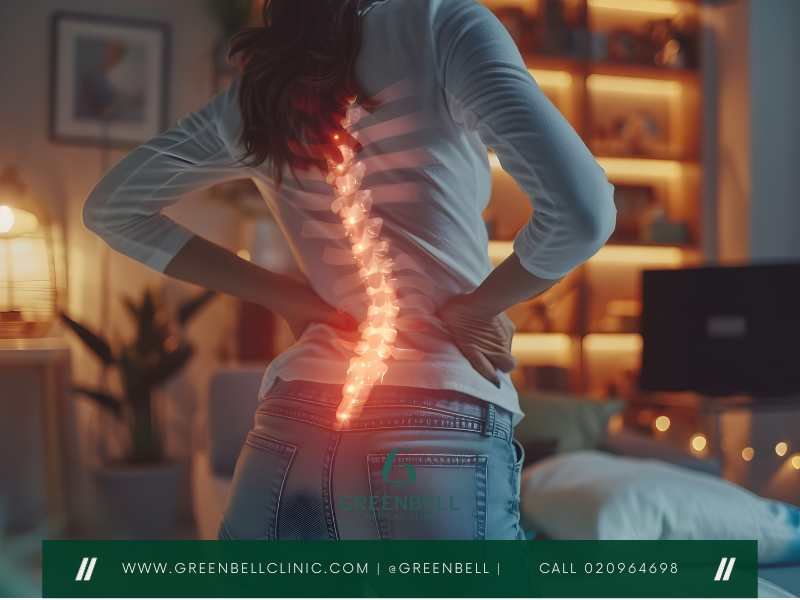The human body is incredibly complex, with the spine being its backbone. The cervical spine, or neck, is key to our daily life. Unfortunately, it can face many disorders, causing health issues.
This article will explore the cervical spine’s anatomy. We’ll look at the vertebrae, discs, muscles, and nerves that support the neck. We’ll also discuss common disorders like herniated discs and spinal stenosis. Understanding these can help manage neck problems.
If you’re dealing with neck pain or limited movement, this article is for you. It aims to give you the knowledge to tackle these issues. Let’s dive into the world of the cervical spine and improve your neck health.

Key Takeaways
- The cervical spine is a vital part of the body’s support system, responsible for maintaining posture and enabling movement.
- Disorders affecting the cervical spine can lead to a wide range of issues, including neck pain, limited mobility, and nerve-related problems.
- Understanding the anatomy of the cervical spine, including the vertebrae, discs, muscles, and nerves, is crucial for identifying and managing cervical spine disorders.
- Common cervical spine disorders include herniated discs, spinal stenosis, radiculopathy, and degenerative disc disease, each with unique symptoms and treatment options.
- Seeking professional medical advice and exploring treatment options, such as physiotherapy, can be essential for effectively managing cervical spine disorders and improving overall neck health.
Introduction to Cervical Spine Anatomy
The cervical spine is at the top of the spine, with seven vertebrae. It supports the head and helps with neck movement. Knowing about the cervical spine’s anatomy is key to understanding common problems.
The Vertebrae and Discs
The cervical vertebrae, from C1 to C7, are small and flexible. They help keep the neck stable while allowing it to move freely. Between each vertebra are intervertebral discs, which absorb shock and help with smooth neck movements.
Muscles and Nerves Supporting the Neck
A group of muscles, ligaments, and tendons support the cervical spine. They give the neck strength and flexibility. The sternocleidomastoid and trapezius muscles, for example, help move the head and neck. The cervical spine also has nerves that carry signals between the brain and the body.
Knowing the cervical spine’s anatomy is important. It helps us understand and treat neck problems. By learning about its parts and how they work, we can better handle neck issues.
At the Greenbell Physiotherapy Clinic in Bangkok, we focus on cervical spine disorders. Our team uses proven methods to help you feel better. If you have a herniated disc, spinal stenosis, or any other neck problem, we’re here to help.
Nerves in the cervical spine
Eight pairs of spinal nerves emerge through diminutive apertures (foramina) situated between each vertebral pair within the cervical spine. These nerves are designated as C1 through C8. They facilitate muscular contractions in the neck, shoulder, arm, and hand, while also transmitting sensory information.
- Cervical nerves C1, C2, and C3 govern the movements of the head and neck in forward, backward, and lateral directions. The C2 nerve conveys sensory information from the superior region of the head; C3 transmits sensory input to the lateral aspect of the face and the posterior part of the head.
- Cervical nerve 4 regulates upward movement of the shoulder and is instrumental in the control of the diaphragm (the muscle located at the inferior aspect of the rib cage that assists in respiration). C4 is responsible for sensory perception in specific regions of the neck, shoulders, and proximal arms.
- Cervical nerve 5 oversees the deltoid musculature of the shoulders as well as the biceps. C5 is tasked with conveying sensory information from the upper section of the upper arm extending down to the elbow.
- Cervical nerve 6 manages the extensor muscles of the wrist and plays a role in the modulation of the biceps. C6 is responsible for sensory input on the thumb side of the forearm and hand.
- Cervical nerve 7 regulates the triceps as well as the wrist extensor muscles. C7 is charged with transmitting sensory information from the posterior aspect of the arm extending into the middle finger.
- Cervical nerve 8 is responsible for the functionality of the hands and provides sensory feedback to the ulnar side of the hand and forearm.
Common Cervical Spine Disorders
Cervical spine disorders come in many forms, each with its own symptoms and effects. A common issue is the herniated cervical disc. This happens when the soft disc between vertebrae ruptures or bulges. It puts pressure on the spinal cord or nerve roots.
This can cause neck pain, arm pain, numbness, and muscle weakness. A herniated disc often leads to cervical radiculopathy. This is when a nerve root gets compressed, causing pain, tingling, or numbness in the arm and hand.
Also, a herniated disc can contribute to degenerative disc disease. This is when the discs wear down over time, causing chronic neck pain and stiffness.
It’s important to understand the causes and how these disorders work. This helps doctors diagnose and treat them effectively. By tackling the main problems, healthcare professionals can help patients feel better and improve their lives.

Cervical Spinal Stenosis
Cervical spinal stenosis happens when the neck’s spinal canal narrows. This narrows the spinal cord. It can greatly affect a person’s life, causing many symptoms.
Causes include degenerative changes, bone spurs, and thickened ligaments. Injuries or birth defects can also play a role.
Symptoms include:
- Neck pain and stiffness
- Numbness, tingling, or weakness in the arms, hands, or legs
- Difficulty with balance and coordination
- Difficulty with fine motor skills
- Bowel or bladder dysfunction
In severe cases, it can lead to paralysis or death. So, it’s crucial to get medical help quickly if symptoms appear.
Treatment often starts with physical therapy and pain management. Surgery might be needed for more severe cases.
At the Greenbell Physiotherapy Clinic in Bangkok, our team helps with cervical spinal stenosis. We aim to improve your quality of life. Contact us to learn more about our treatments.
Cervical Radiculopathy
Cervical radiculopathy is a common neck and upper arm issue. It happens when a nerve in the neck gets compressed or irritated. This can cause a lot of symptoms that affect daily life.
Symptoms and Diagnosis
The main symptom is neck pain that can spread to the arm and hand. People might feel numbness, tingling, or weakness in their arm. Pain can get worse with certain neck movements or activities.
Doctors diagnose cervical radiculopathy through a detailed physical check-up. They look at the patient’s neck movement, reflexes, and muscle strength. Imaging tests like X-rays, MRI, or CT scans might be used to find the cause. This could be a herniated disc, bone spur, or other spinal issue.
- Neck pain
- Radiating arm or hand pain
- Numbness or tingling in the affected limb
- Weakness in the arm or hand
Getting a quick diagnosis and proper treatment is key to managing cervical radiculopathy. At Greenbell Physiotherapy Clinic in Bangkok, our team is expert in treating cervical spine issues. We help patients find relief and improve their quality of life.
Degenerative Disc Disease
Degenerative disc disease is a common issue that affects the cervical spine’s discs. It causes neck pain, stiffness, and other symptoms. This section explores the risk factors and how to prevent or manage it through lifestyle changes and medical treatments.
Risk Factors for Degenerative Disc Disease
Several factors can lead to degenerative disc disease in the cervical spine:
- Aging: As we age, our spine’s discs wear down and lose their cushioning ability.
- Injury or trauma: Sudden or repetitive strain on the neck can damage discs and speed up degeneration.
- Genetics: Some people may be more likely to develop this disease due to their genes.
- Obesity: Extra weight puts more stress on the cervical spine’s discs, causing them to deteriorate faster.
- Sedentary lifestyle: Not being active weakens neck muscles, making discs more susceptible to damage.

Preventing Degenerative Disc Disease
While some risk factors are unavoidable, there are steps to prevent or manage degenerative disc disease:
- Keep a healthy weight with a balanced diet and regular exercise.
- Do low-impact activities like yoga, Pilates, or swimming to strengthen neck and back muscles.
- Practice good posture and avoid long periods of sitting or standing.
- Seek a physiotherapist, like those at the Greenbell Physiotherapy Clinic in Bangkok, for a personalized plan.
- If pain or discomfort lasts, see a doctor for a diagnosis and treatment options.
Understanding risk factors and taking proactive steps can help maintain cervical spine health. This reduces the impact of degenerative disc disease.
Cervical Spine Anatomy Disorder
Disorders in the cervical spine, or neck area, can greatly affect spinal health. Issues like herniated discs and degenerative changes are common. It’s important to know the cervical spine’s anatomy to manage these problems well.
The cervical spine has seven vertebrae, crucial for head support and movement. Discs between them absorb shock, and muscles and nerves provide stability and nerve signals. Damage to these parts can lead to various disorders.
| Disorder | Description | Potential Causes |
|---|---|---|
| Cervical Radiculopathy | Compression or irritation of the nerve roots, leading to pain, numbness, and tingling in the arms and hands. | Disc herniation, bone spurs, or degenerative changes in the spine. |
| Cervical Spinal Stenosis | Narrowing of the spinal canal, which can put pressure on the spinal cord and nerve roots. | Osteoarthritis, disc degeneration, or congenital abnormalities. |
| Degenerative Disc Disease | Gradual wear and tear of the intervertebral discs, leading to pain, stiffness, and decreased mobility. | Aging, injury, or genetic factors. |
These are just a few examples of cervical spine anatomy disorders affecting the neck. Knowing the causes, symptoms, and treatments is key to a healthy cervical spine.
Neck Pain and Its Causes
Neck pain is a common problem that can really affect your life. It can come from different cervical spine disorders. Whiplash injury is one of the main causes of neck pain.
Whiplash Injury
Whiplash happens when your head suddenly moves forward and backward. This often happens in car accidents. It can hurt the muscles, tendons, and ligaments in your neck.
This can cause pain, stiffness, and make it hard to move your neck. Symptoms of whiplash might not show up right away. They can include:

- Neck pain and stiffness
- Headaches
- Dizziness or vertigo
- Numbness or tingling in the arms or hands
- Difficulty concentrating or memory problems
If you have these symptoms, see a doctor right away. Early treatment can stop long-term neck pain and other problems.
Cervical spondylosis is another reason for neck pain. It’s a condition that affects the discs and joints in the neck. As we get older, these discs can wear down, causing pain and stiffness.
Good posture, regular exercise, and physiotherapy can help with cervical spondylosis symptoms. If your neck pain doesn’t go away, see a doctor. The team at Greenbell Physiotherapy Clinic in Bangkok can help find the cause and treat it.
Cervical Spondylosis
Cervical spondylosis is a condition that affects the neck. It causes pain, stiffness, and less mobility. It’s common as people get older.
The condition happens when the neck’s vertebrae and discs wear out. This can put pressure on nerves, causing pain and numbness in the arms and hands. Neck pain, stiffness, and numbness are common symptoms.
People with cervical spondylosis may find it hard to move. This makes simple tasks tough. In severe cases, it can even narrow the spinal canal, leading to more serious problems.
Dealing with cervical spondylosis needs a mix of treatments and lifestyle changes. Physiotherapy is key in treating the condition. It helps reduce symptoms and improves life quality.
At Greenbell Physiotherapy Clinic in Bangkok, we specialize in treating degenerative disc disease and other neck problems. We create personalized plans for each patient. Our plans include manual therapy, exercises, and special equipment to help you feel better.
| Symptom | Description |
|---|---|
| Neck Pain | Dull, aching, or sharp pain in the neck region, often exacerbated by movement |
| Stiffness | Reduced range of motion and difficulty turning or tilting the head |
| Numbness/Tingling | Tingling, numbness, or weakness in the arms, hands, or fingers |
| Headaches | Tension-type headaches or migraines associated with cervical spondylosis |
If you or a loved one is dealing with cervical spondylosis, contact Greenbell Physiotherapy Clinic in Bangkok. Our team offers a comprehensive treatment plan. We aim to help you live a pain-free life and move freely again.
Spinal Cord Compression
Spinal cord compression is a serious issue that can come from cervical spinal stenosis. It happens when the spinal cord gets squished. This can cause neck pain, numbness, weakness, and even paralysis if not treated.
Treatment Options
There are many ways to treat spinal cord compression. The choice depends on the cause and how bad it is.
For mild to moderate cases, conservative treatments are often the first step. These include:
- Physical therapy to improve posture, flexibility, and strength
- Anti-inflammatory medications to reduce swelling and pain
- Epidural steroid injections to alleviate inflammation
- Lifestyle modifications, such as weight loss and improved ergonomics
For severe cases or when other treatments don’t work, surgical interventions might be needed. These can include:
- Decompression surgery to remove bone or disc material that is compressing the spinal cord
- Fusion surgery to stabilize the affected vertebrae and prevent further compression
- Laminectomy to create more space for the spinal cord by removing a portion of the vertebral bone
At the Greenbell Physiotherapy Clinic in Bangkok, our team is here to help. We treat spinal cord compression and other cervical spine disorders. We create treatment plans that help our patients improve their quality of life.
| Treatment Approach | Description | Typical Outcomes |
|---|---|---|
| Conservative Treatment | Includes physical therapy, anti-inflammatory medications, and lifestyle modifications | Effective in mild to moderate cases, can provide pain relief and improved function |
| Surgical Intervention | Includes decompression, fusion, and laminectomy procedures | Can provide more significant relief in severe or unresponsive cases, but carries higher risks |
Diseases and Disorders Affecting the Cervical Spine
The cervical spine, the top seven vertebrae, can face many diseases and disorders. These can greatly affect a person’s health. Knowing about these ailments is key for proper diagnosis and treatment.
Cervical spondylosis is a common issue. It’s caused by wear and tear on the vertebrae and discs. This can lead to bone spurs that press on nerves, causing neck and arm pain.
Cervical spinal stenosis narrows the spinal canal. This can compress nerves, leading to neck pain and weakness. Cervical radiculopathy, where a nerve root is compressed, also causes discomfort and neurological symptoms.
Traumatic injuries, like whiplash, can harm the cervical spine. They can cause pain, stiffness, and limited movement. In severe cases, these injuries can lead to long-term neurological problems.

| Cervical Spine Disorder | Symptoms | Potential Complications |
|---|---|---|
| Cervical Spondylosis | Neck pain, stiffness, numbness, weakness | Spinal cord or nerve root compression |
| Cervical Spinal Stenosis | Neck pain, tingling, weakness, paralysis | Spinal cord compression |
| Cervical Radiculopathy | Radiating pain, numbness, tingling in the arm | Muscle weakness, loss of reflexes |
| Whiplash Injury | Neck pain, stiffness, headaches, dizziness | Spinal cord compression, neurological deficits |
These are just a few examples of diseases and disorders affecting the cervical spine. Getting medical help quickly is crucial. Working with healthcare experts, like those at the Greenbell Physiotherapy Clinic in Bangkok, is important for managing these complex conditions.
Role of Physiotherapy in Cervical Spine Disorders
Physiotherapy is key in managing cervical spine disorders. It uses special techniques to ease neck pain and boost spinal health. The Greenbell Physiotherapy Clinic in Bangkok is a top choice for such care.
Greenbell Physiotherapy Clinic Bangkok
The Greenbell Physiotherapy Clinic is in Bangkok’s heart. It’s known for its top-notch care in cervical spine issues. The team of skilled physiotherapists offers services tailored to each patient.
At Greenbell, patients get a detailed check-up and a treatment plan. This plan might include:
- Manual therapy to improve joint mobility and reduce pain
- Therapeutic exercises to strengthen neck muscles and boost flexibility
- Postural reeducation and ergonomic advice to prevent injury
- Thermal modalities like heat or ice to manage inflammation and pain
- Electrical stimulation to ease discomfort and aid healing
The clinic is known for its personalized care. They help with herniated discs, cervical spinal stenosis, and more. Their goal is to help you move better, feel less pain, and live better.
Conclusion
Understanding the cervical spine and its disorders is key to keeping your spine healthy. This includes issues like herniated discs and spinal stenosis. This article has covered common problems that can cause neck pain and other issues.
If you have ongoing or severe neck pain, get medical help right away. The team at Greenbell Physiotherapy Clinic in Bangkok can help. They offer treatments like manual therapy and exercises to help you feel better.
Looking after your cervical spine is important. Knowing about its anatomy and the signs of problems can help. With the right care, you can manage neck issues and live a more active life.





